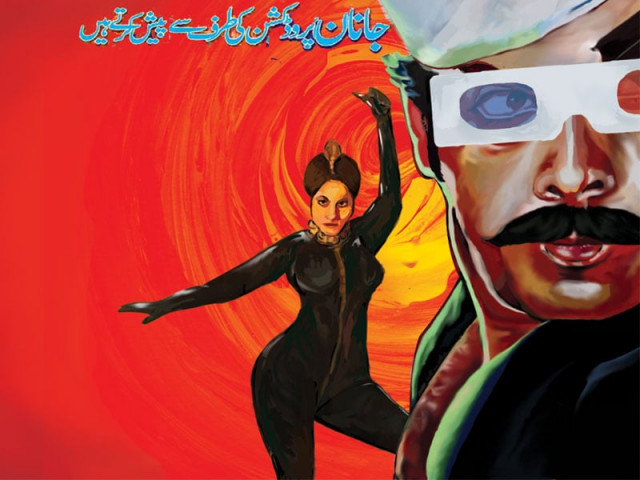The Sultan of screens
Launched in December 2010, Atrium Cinemas have gone on to become the toast of the town.

The Sultan of screens
Tired of sitting in the waiting lounge, despite all its comfort and tasteful decor, I decided to take a walk around the cinema to find out what was causing all the commotion. Unable to see anyone else free to talk, I asked a sweeper what the celebration was about and that too at three in the afternoon on a working day. “Actually Don 2 has become a super hit and it’s doing great business so we are celebrating. And the new Mission Impossible [film] starring Tom Cruise has also had a great start,” he tells me confidently.
I was impressed. Call it my naiveté, but I had not expected such a detailed response from a sweeper. Clearly, the extraordinary success of Atrium Cinemas has managed to capture everyone’s attention and interest. And the fact that he used the word ‘we’ shows another business success — a well-integrated and motivated team.
“Atrium is not a trendsetter, it’s a game changer,” Mandviwalla tells me, as we finally sit down to talk in his office and I tell him I would want to discuss with him the new trend that his cinema has set. He walks over to a huge LCD screen that divides up into six smaller screens, each displaying footage from a separate security camera. The first one showed about 20 people, apparently running late for a show, rushing through an escalator; the second showed three long queues in front of the ticket counters while the other four showed each of the theatres filling up quickly as people took their seats.
Launched in December 2010, Atrium Cinemas have gone on to become the toast of the town. Located in Saddar, one of Karachi’s oldest and busiest commercial areas, the four-screen multiplex is housed in a mall that has barely opened up yet but is already a household name due to the phenomenal popularity of the cinemas. Always one to do it in style, Mandviwalla managed to acquire a special director’s cut of Avatar 3D, one of the biggest hits of 2009 internationally, to launch the cinemas.
“We were not sure how big the Atrium project would be but we had a certain projected figure in mind in terms of business, and we achieved double that number. It was a pleasant surprise for me,” says Mandviwalla, who has seen the sudden resurgence of cinema from years of decay.
Although his selection of the first-ever film to show at Atrium Cinemas shows great business acumen, the location was a gamble. Before Atrium’s rise, the Universe Cineplex, located in the upscale residential area of DHA, had a monopoly over film audiences in Karachi and many were reluctant to travel to the ‘other side of the bridge’ to Atrium. The dismal condition of cinemas like Bambino, not too far away from Atrium, did not help.
Today, due to its superior quality and viewing experience, Atrium attracts cinegoers from North Nazimabad to Clifton. “It was a real challenge to make the residents of Defence and Clifton cross the infamous Clifton Bridge at night,” he admits. “We managed to do that by giving them an experience that was worth taking a risk and paying for.”
The success is endorsement and Mandviwalla stands by his choice of location. “Those who argue that Clifton has become the centre of the city are wrong. Saddar was and will remain the centre, at least for cinema-going audiences,” he asserts.
The numbers certainly bear out Mandviwala’s claims. In 2011, the first full year of operations for the cinema, it attracted just shy of 620,000 viewers, who spent about Rs238 million watching the 86 movies that were screened at Atrium.
Buoyed on by the momentum, he plans to add two more screens to Atrium and another, more expensive but limited seating screen by the name of ‘Cinegold’ by the end of the year. “It will be the business class of screens — highly priced but equally well-facilitated,” explains Mandviwalla.
But success hardly comes without controversy, and Atrium has had its share. Owners of Bambino Cinema, which is suffering because of an abysmally low turnout, have blamed distributors particularly Mandviwalla for not providing them with Indian films.
He brushes aside these claims and cites the example of Nishat Cinema, which he revamped a few years ago. “When I was renovating Nishat, everyone was sceptical and said that cinema is a dead medium. Today, when they are not getting audiences, and as a result Indian films, due to their own negligence, they are making an issue out of it,” he responds.
With hugely successful projects like Lahore’s DHA Cinema, Cinegold and Cinestar already under his belt, Mandviwalla is not new to revamping spaces to make them into cinemas or reinventing existing ones. “Nishat still generates the most revenue in Pakistan in its own league of circuit cinemas,” he says.
So what is at the root of the downfall of Pakistani cinema, I ask him, taken in by his optimism. “For the past 30 years, there were two deterrents: hardware and software,” Mandviwalla explains. From 1971 to 2001, the government had enforced a very high entertainment duty on cinema tickets. It was higher for Urdu and Punjabi films and lower for films in other regional languages such as Sindhi and Pashto. In the late 1980s, the duty was increased even further and reached 100 to 150 per cent, making it extremely unfeasible for everyone who was part of the business from the filmmaker to the distributor. “So cinemas started closing down. No one took it as serious business. In simpler words, there weren’t enough screens or hardware anymore. Since there wasn’t sufficient hardware, you didn’t get any films or software to run on it. The ban on showing Indian films, that wasn’t lifted until late the 2000s, also played a significant role,” he says.
After hectic lobbying and efforts, the entertainment duty has now been reduced to 55 to 65 per cent, making business feasible for everybody. “Now is the right time to invest in cinema!” he declares emphatically.
Mandviwalla and his contemporaries are now working towards an exemption of duties on cinema tickets so that potential investors can be attracted and the industry spurred back into action. “I am optimistic that it might actually happen. The goal is to multiply the number of screens in two to three years instead of 10 to 30 years. This is a crunch time for Pakistani cinema,” he says in a rather concerned tone.
Pakistani audiences are obviously hungry for indigenous entertainment and have spoken by giving an exceptional response to Shoaib Mansoor’s Bol. At 43,071 viewers, Bol is the all-time most popular film at Atrium. Ironically, the least popular film is also a Pakistani product Son of Pakistan, which managed to attract only 56 viewers.
As screens begin to multiply, it will encourage filmmakers to produce more films as economics begins to work in their favour. Currently, there are 38 working screens in Pakistan and every screen gives a weekly business of one million rupees. Making an average Pakistani film costs between 25 and 30 million rupees and if it runs for approximately two weeks — the average run for a hit film — the makers are hardly able to break even given the current situation.
“Once screens are multiplied, filmmakers will begin producing films not just for the heck of it but for actually making serious money. That is when our industry will be revived,” he says.
And he is optimistic that enough screens will begin functioning in just a matter of time. “Karachi’s true potential is of 100 screens. If everything goes according to plan, I foresee another 20 screens coming up in three years’ time and 100 in just 10,” Mandviwalla says confidently.
Published in The Express Tribune, Sunday Magazine, July 1st, 2012.



















COMMENTS
Comments are moderated and generally will be posted if they are on-topic and not abusive.
For more information, please see our Comments FAQ